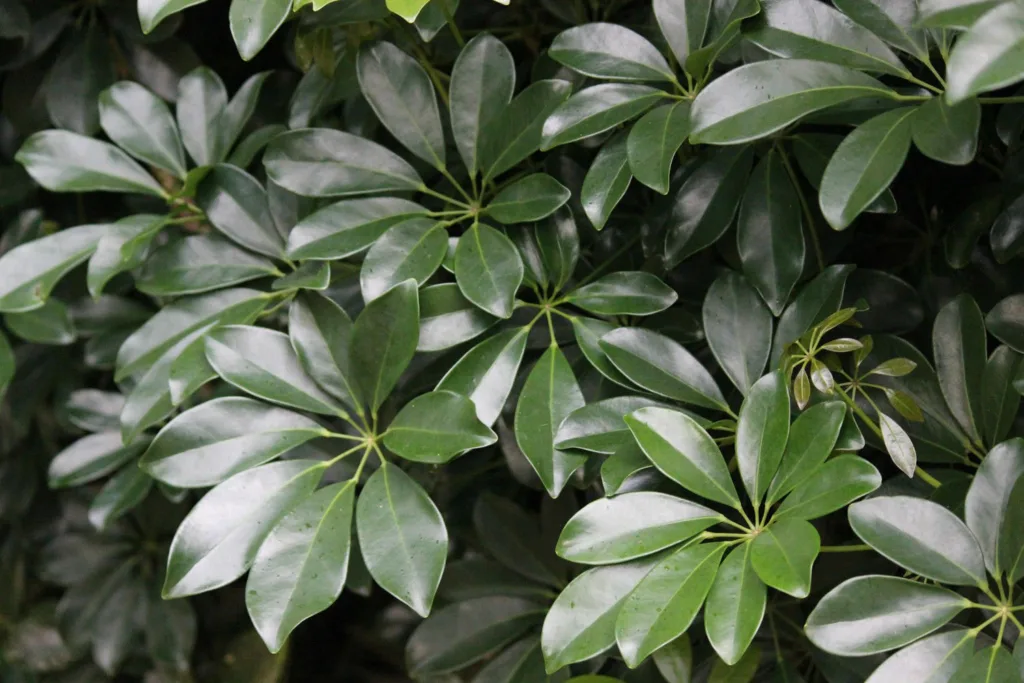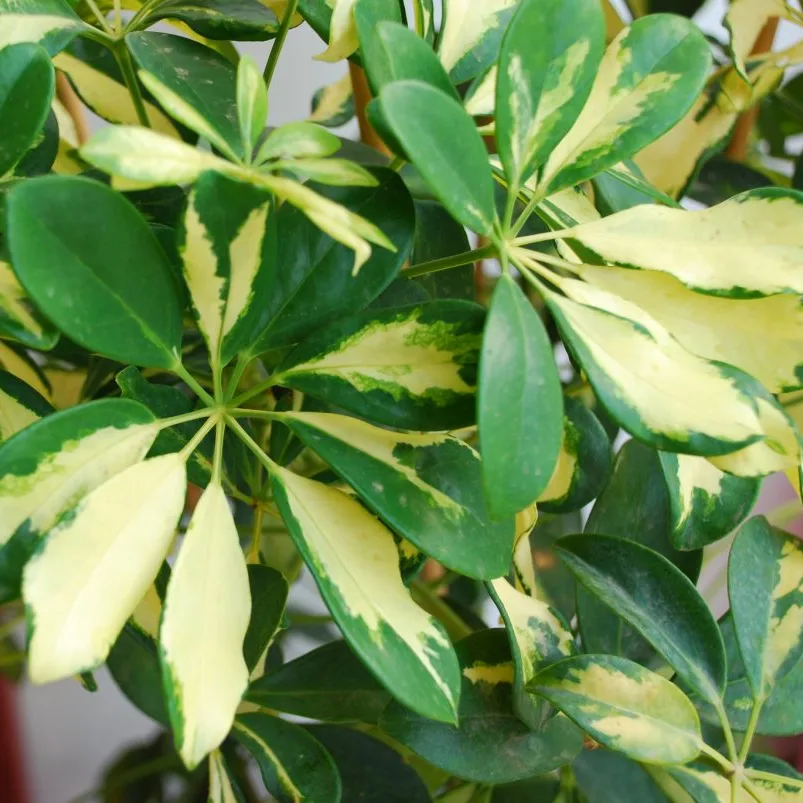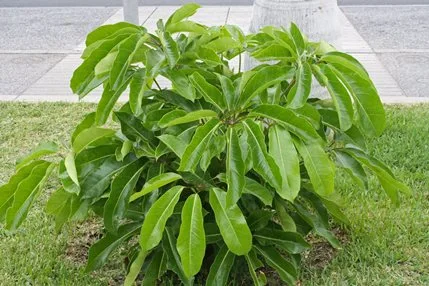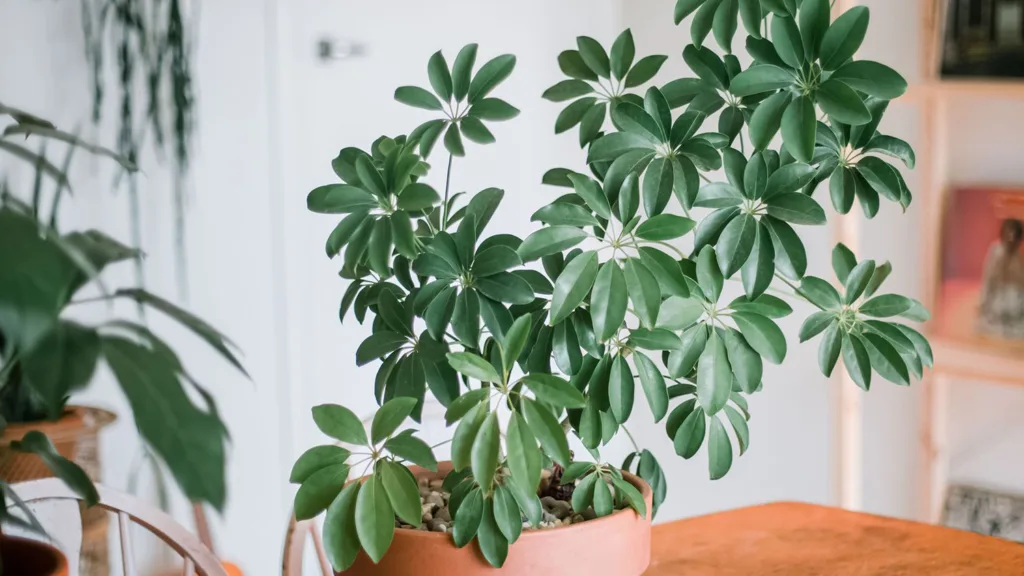Introduction
Schefflera actinophylla, also known as the umbrella tree, is an impressive tropical plant that belongs to the Araliaceae family. Originally from Australia, this plant is recognizable by its bright green leaves and unique structure, which resembles an open umbrella. Schefflera actinophylla is widely cultivated as an ornamental plant due to its elegant and exotic appearance. Its leaves are compound and can be very large, creating a striking look. It is popular both indoors and outdoors due to its ability to adapt to different conditions.
table of contents
Meaning and Symbolism
Although the Schefflera actinophylla is not typically associated with symbolic meanings, its exuberant and vibrant appearance can be interpreted as a symbol of vitality and growth. Its dense, expansive foliage can be seen as a reflection of prosperity and abundance, making it a popular choice for interior decoration in many cultures. It is important to mention that, in some regions, Schefflera actinophylla is considered an invasive plant, and its planting may be regulated. Therefore, when growing this plant, it is essential to be aware of local conditions and cultivation guidelines.
| Common Name | Schefflera actinophylla |
|---|---|
| Botanical Name | Schefflera actinophylla |
| Family | Araliaceae |
| Plant Type | Shrub / Tree |
| Size Adult | 3 to 15 meters high |
| Sun exposure | Indirect light to full sun |
| Soil type | Rich in organic matter, adequate drainage |
| soil pH | Slightly acidic to slightly alkaline (6.0 to 7.5) |
| Flowering time | Spring to summer |
| Flower color | Red, orange, yellow |
| Native Area | Australia, New Guinea and Indonesia |
| Toxicity | Potentially toxic to pets |
Remember that Schefflera actinophylla is toxic to pets, so take precautions when growing it in places where your pets can access it.

Caring for Schefflera actinophylla
Schefflera actinophylla, also known as the Umbrella Tree, is a popular plant for decorating interiors and gardens due to its lush appearance and tropical foliage. To ensure that your Schefflera grows and blooms vigorously, it is essential to provide it with the right care conditions. Below you will find detailed information on how to properly care for your Schefflera:
Light Schefflera actinophylla likes bright light, but not direct. Place it near a window with indirect light or in partial shade. Avoid direct sunlight, as this can burn the leaves.
Soil Use a soil rich in organic matter and with good drainage capacity. A standard potting soil works well. Make sure the pot has drainage holes to prevent water from accumulating.
Water Water your Schefflera moderately. Allow the soil to dry out slightly between waterings, as it prefers moist, but not soggy, soil. Avoid overwatering, as this can lead to root rot.
Temperature and humidity Schefflera thrives in medium to warm conditions. Keep it in a place with a temperature between 18°C and 24°C. It also appreciates an environment with a reasonable level of humidity. If the air is too dry, consider using a humidifier or spraying water on the leaves.
Fertilizing Fertilize your Schefflera during spring and summer, when it is actively growing. Use a balanced water-soluble fertilizer, diluted by half, every four to six weeks. Reduce fertilization during autumn and winter, when its growth slows down.
By following these care guidelines, you can enjoy a healthy and lush Schefflera actinophylla in your indoor environment or garden. Make sure to regularly monitor its specific needs and adjust care as necessary to keep it in optimal condition.
Types of Schefflera actinophylla
Schefflera actinophylla, also known as the Umbrella Tree, has several varieties and cultivars that have some differences in their characteristics, such as size, leaf shape and growth patterns. Here are some of the most common types of this plant:
- Schefflera actinophylla (Standard): This is the typical variety, known for its large, lush leaves with an appearance reminiscent of an umbrella. It can reach a considerable height when grown in ideal conditions.
- Schefflera actinophylla ‘Amate’: A smaller variety of theUmbrella Tree, ‘Amate’ has smaller leaves and a more compact growth. It is an excellent choice for smaller spaces or as an indoor plant.
- Schefflera actinophylla ‘Gold Capella’: This variety has variegated leaves with yellowish or golden margins. It adds a touch of color to the room and is popular as an ornamental plant.
- Schefflera actinophylla “Trinette “: Similar to “Gold Capella,” “Trinette” has variegated leaves, but with a different combination of colors, including white, green and pink.
- Schefflera actinophylla “Dwarf Umbrella Plant”: As the name suggests, this variety is a smaller version of the standard Schefflera, making it a more manageable option for smaller spaces.
- Schefflera actinophylla “Green Queen”: A variety with narrower, darker leaves, the “Green Queen” is appreciated for its elegant appearance.
- Schefflera actinophylla “Tropic Snow”: Another variegated variety, ‘Tropic Snow’ features leaves with white and green spots, creating a unique look.
Remember that the exact characteristics of each type can vary, and the choice of Schefflera type will depend on your personal preferences and the space available for cultivation. Regardless of the type you choose, all varieties of Schefflera actinophylla share similar care needs in order to thrive.

How to Prune Schefflera actinophylla: Importance and Techniques
Pruning is an essential practice in the care of Schefflera actinophylla, also known as the Umbrella Tree. It helps keep the plant healthy, stimulates more robust growth and controls its size. Here is some important information about pruning this plant:
Why is pruning important?
- Stimulates healthy growth: Regular pruning removes dead or diseased leaves and branches, encouraging the plant to direct its energy into growing healthy new tissue.
- Controls size: Schefflera actinophylla can grow quite large, and pruning helps keep it at an appropriate size for the environment in which it is grown.
- Improves aesthetics: Removing old, worn-out leaves contributes to a more beautiful and lush appearance.
Pruning techniques
- Removing dead leaves: Use clean, sharp pruning shears to carefully cut away dead or yellowed leaves. Cut close to the main stem, but do not damage the trunk.
- Pruning branches: If the plant is too dense or has branches growing untidily, you can prune these back to the main trunk. Make sure you cut above a node or fork to encourage lateral growth.
- Maintenance pruning: Carry out maintenance pruning during spring or summer, when the plant is actively growing. Avoid pruning too much during the winter, as this can stress the Schefflera.
How to make Schefflera actinophylla seedlings
Propagating Schefflera actinophylla is possible, but it is usually done through cuttings. Here are the basic steps for propagating your Umbrella Tree:
- Choose a cutting: Select a healthy cutting with at least two nodes (the points where the leaves are attached to the stem).
- Cut the cutting: Use sharp pruning shears to cut the cutting just below a node. Remove all the leaves from the cutting, except for a few at the top.
- Rooting: Plant the cutting in a light, well-drained substrate. Keep the soil moist but not soggy. Cover the cutting with a transparent plastic bag to create a humid environment and keep it in a place with indirect light.
- Transplant: After a few weeks, the cutting should develop roots. At this point, you can transplant it into a larger pot with potting soil.

How to Plant Schefflera actinophylla Step by Step
Now that you know about pruning techniques and how to propagate Schefflera, here is a step-by-step guide on how to plant and care for this plant:
- Choosing apot: Select a pot with good drainage to avoid water accumulation. Make sure the pot is big enough to accommodate the plant and has holes in the bottom.
- Soil: Use a light, well-aerated soil, such as a potting mix with good drainage.
- Planting: Plant your Schefflera taking care to maintain the same depth as before. Press the soil around the plant to secure it.
- Watering: Keep the soil slightly moist, allowing the top layer of soil to dry out between waterings. Avoid waterlogging the soil.
- Light: Place your Schefflera in a spot with bright indirect light. Avoid intense direct sunlight, which can burn the leaves.
- Temperature and humidity: Keep the plant in an environment with a moderate temperature and medium humidity.
- Fertilization: Feed your Schefflera with a balanced fertilizer during the growing season (spring and summer), following the instructions on the label.
Most common pests and diseases
Schefflera actinophylla, like any other plant, is susceptible to various pests and diseases that can affect its health. Here are some of the most common ones to look out for:
- Mealybugs: Small insects that feed on the sap of the leaves, leaving a sticky substance behind. Wash the leaves with soap and water or use neem oil.
- Aphids: Other sap-sucking insects that can cause leaf deformities. Remove them with a jet of water or use insecticidal soap.
- Fungi: Excessive humidity can cause fungi to develop, resulting in leaf spots. Avoid overwatering and ventilate the room.
- Root rot: Excess water can lead to root rot. Make sure the soil has good drainage and don’t leave the plant in standing water.
- Yellowing of the leaves: This can be caused by too much direct light. Move the plant to a place with indirect light.
Common problems and their solutions
When caring for your Schefflera, you may encounter some common problems. Here are solutions to these issues:
- Withered leaves: This can be the result of inadequate watering. Check that the soil is dry before watering again.
- Yellowing leaves: This can be caused by a lack of nutrients. Feed the plant with a balanced fertilizer.
- Falling leaves: Schefflera can lose leaves in winter as part of its natural cycle. If this happens, continue with normal care.
Advanced Care and Maintenance Tips
In addition to basic care, there are some advanced tips for keeping your Schefflera healthy:
- Pruning: Do light pruning to shape the plant and remove diseased leaves or branches.
- Transplant: Every 2-3 years, consider transplanting your Schefflera into a slightly larger pot.
- Cleaning: Regularly wipe the leaves with a damp cloth to remove dust buildup.
- Propagation: You can propagate your Schefflera from stem cuttings.
With this information, you’ll be better prepared to look after and keep your Schefflera actinophylla healthy and lush.

Curiosities and myths
Plants always carry an aura of curiosity and, often, myths surrounding them. Let’s explore some curiosities and debunk some myths about Schefflera actinophylla:
1. Popular Name and Origin: Schefflera actinophylla is commonly called the “Umbrella Tree” due to the appearance of its leaves. It is native to the tropical regions of Australia, New Guinea and Java.
2. Amazing growth: This plant is known for its rapid and vigorous growth. It can grow up to 3 meters in height under ideal conditions.
3. Lucky symbol: In some cultures, the Schefflera is considered a symbol of good luck and prosperity, especially when grown indoors. It is often given away at house and office openings as a gesture of good luck.
4. Toxic Leaves: While Schefflera is an attractive plant, its leaves are toxic to pets such as cats and dogs. So be careful when growing it in places accessible to pets.
5. Purified air: In addition to its beauty, Schefflera is appreciated for its ability to purify the air. Its leaves help remove toxins from the indoor environment.
6. Myths and Superstitions: There are many myths about plants, including the belief that the Schefflera attracts financial prosperity. Although it is a symbol of luck in some cultures, it is important to remember that true financial success depends on much more than just one plant.
Now that you know a few facts and myths about Schefflera actinophylla, you can enjoy this fascinating plant even more in your garden or indoors.
Conclusion
Throughout this guide to caring for Schefflera actinophylla, we’ve explored the essential aspects of ensuring that this plant grows healthy and lush in your space. From information on its origin to specific care tips, we hope you’ll feel more confident about growing and maintaining this lovely umbrella tree.
By always remembering the importance of adequate light, well-drained soil, moderate watering and protection from pests and diseases, you’ll be well prepared to enjoy the beauty and benefits of this plant. With Schefflera actinophylla in your home or garden, you’ll not only be adding a touch of green, but also a symbol of luck and prosperity. So grow it with love, look after it with care and let this amazing plant flourish in all its glory. Welcome to the enchanting world of gardening with Schefflera!
Frequently Asked Questions
What does the cheflera plant mean?
The Schefflera plant, also known as “Cheflera,” has different meanings in different cultures. Generally, it is associated with prosperity, good luck and energy balance in the environment in which it is placed.
How to water cheflera?
To water Cheflera:
Water when the top of the soil is dry to the touch.
Avoid waterlogging; Cheflera prefers slightly damp soil.
Make sure the pot has good drainage to avoid waterlogged roots.
What are the benefits of the cheflera plant?
To care for Cheflera in a pot:
Choose a pot with adequate drainage.
Keep it in places with indirect to bright light.
Fertilize monthly during the growing season.
Reduce watering during the winter to avoid excess moisture.
Monitor the plant for pests and treat when necessary.
How to care for cheflera in a pot?
To care for Cheflera in a pot:
Choose a pot with adequate drainage.
Keep it in places with indirect to bright light.
Fertilize monthly during the growing season.
Reduce watering during the winter to avoid excess moisture.
Monitor the plant for pests and treat when necessary.








